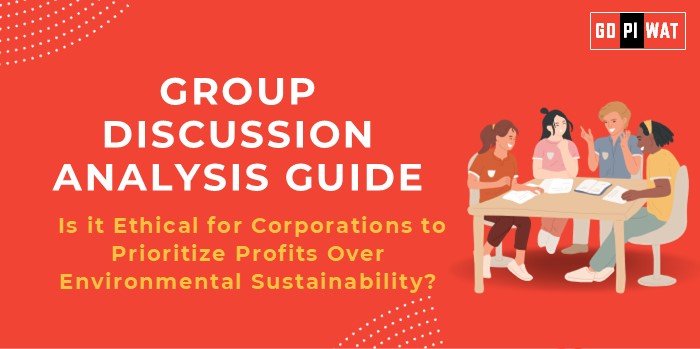📋 Group Discussion Analysis Guide: Is it Ethical for Corporations to Prioritize Profits Over Environmental Sustainability?
🌐 Introduction to the Topic
📖 Opening Context
“The tug-of-war between corporate profitability and environmental stewardship epitomizes the ethical dilemmas of modern capitalism, especially as the global climate crisis intensifies.”
📜 Background
The debate has grown amidst rising corporate influence and urgent environmental challenges, with global initiatives like the Paris Agreement urging businesses to act responsibly.
📊 Quick Facts and Key Statistics
- 🌍 Global Emissions Contribution: Top 100 corporations account for 71% of global emissions (CDP Report 2023).
- 🤝 Consumer Sentiment: 88% of consumers prefer sustainable brands (Nielsen, 2023).
- 📈 ESG Investments: $35 trillion allocated to ESG funds worldwide in 2022, highlighting financial potential in sustainability.
- 📜 Regulatory Trends: Over 50 countries have mandatory environmental reporting laws (World Bank, 2023).
👥 Stakeholders and Their Roles
- 🏢 Corporations: Key decision-makers, balancing profits with sustainable practices.
- 🏛️ Governments: Regulators enforcing environmental laws and incentivizing green practices.
- 🛍️ Consumers: Advocates for sustainability, influencing corporate behavior through purchasing choices.
- 🌱 NGOs and Activists: Watchdogs and influencers pushing for accountability and ethical practices.
📈 Achievements and Challenges
🏆 Achievements
- 🚗 Green Innovations: Tesla’s market success underscores the profitability of sustainable ventures.
- 📊 ESG Integration: Companies like Unilever report 70% faster growth in sustainable brands.
- 🔋 Renewable Energy Adoption: Amazon aims for 100% renewable energy use by 2030.
⚠️ Challenges
- 💸 Profit Trade-offs: High upfront costs deter widespread adoption.
- 🟢 Greenwashing: Misleading sustainability claims undermine genuine efforts.
- 🌍 Regulatory Evasion: Limited enforcement in developing regions.
🌍 Global Comparisons
Success: Scandinavian nations have achieved significant emissions reductions through corporate accountability.
Challenges: Developing nations face barriers due to cost and infrastructure constraints.
💡 Case Studies:
- 🌱 Patagonia: Demonstrates profitability through sustainability.
- ⚠️ Volkswagen Scandal: Highlights the risks of ethical lapses.
📋 Structured Arguments for Discussion
- ✅ Supporting Stance: “Prioritizing profits ensures a corporation’s survival, which can fund long-term sustainability efforts.”
- ❌ Opposing Stance: “Ignoring environmental sustainability compromises societal and ecological well-being, outweighing profit motives.”
- ⚖️ Balanced Perspective: “Profit and sustainability need not be mutually exclusive; strategic integration can yield long-term benefits.”
💡 Effective Discussion Approaches
🌟 Opening Approaches
- 💬 Quote: “Profit-driven decisions must respect the boundaries of environmental ethics—profit without a planet is unsustainable.”
- 📖 Case Study: Highlight Patagonia’s sustainable business model.
⚔️ Counter-Argument Handling
- 🔍 Use facts to challenge greenwashing claims.
- 💡 Suggest innovative funding models like green bonds for costly transitions.
🔍 Strategic Analysis of Strengths and Weaknesses
- 💪 Strengths: Growing market for sustainable products; regulatory support.
- 📉 Weaknesses: High costs of sustainable transitions; resistance to change.
- 🌱 Opportunities: Expansion of ESG funds; consumer demand for transparency.
- ⚠️ Threats: Reputational risks; stricter regulations and penalties.
🔗 Connecting with B-School Applications
- 📘 Real-World Applications: Explore this topic in courses on Corporate Social Responsibility or Sustainability in Operations.
- ❓ Sample Questions:
- 💭 “How can corporations balance shareholder value with environmental impact?”
- 🤔 “What strategies help mitigate greenwashing risks?”
- 📚 Insights for Students:
- Focus on innovations like carbon offsets and renewable energy for internships or projects.


